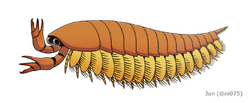Biology:Haikoucaris
| Haikoucaris | |
|---|---|

| |
| Reconstruction of Haikoucaris ercaiensis | |
| Scientific classification | |
| Domain: | Eukaryota |
| Kingdom: | Animalia |
| Phylum: | Arthropoda |
| Class: | †Megacheira |
| Clade: | †Cheiromorpha |
| Genus: | †Haikoucaris Chen et al., 2004 |
| Species: | †H. ercaiensis
|
| Binomial name | |
| †Haikoucaris ercaiensis Chen et al., 2004
| |
Haikoucaris is a genus of megacheiran arthropod that contains the single species Haikoucaris ercaiensis. It was discovered in the Cambrian Chengjiang biota of China .[1]
Morphology
Haikoucaris measured about 38 mm in body length.[1] The elongated body compose of a semicircular head shield, 13 trunk tergites and presumely a short, spine-like telson.[1][2] The head possess a pair of unstalked eyes, a pair well-developed great appendages, as well as 3 more appendage pairs of unknown detail.[2] Each of the great appendage consists of a 2-segmented peduncle and a 3-segmented claw.[2] Each of the trunk segment possess a pair of biramus appendages that each comprising a leaf-shaped exopod and a possibly 7-segmented endopod.[2]
Paleoecology
Haikoucaris may have been a predator, with its great appendages and exopod suggested to be used for hunting and swimming respectively.[2]
Taxonomy
Within megacheirans, Haikoucaris is generally accepted to be a member of the clade Cheiromorpha alongside Yohoia and Leanchoiliidae.[3][4][5][6]
See also
- Cambrian explosion
- Chengjiang biota
- List of Chengjiang Biota species by phylum
References
- ↑ 1.0 1.1 1.2 Chen, Junyuan; Waloszek, Dieter; Maas, Andreas (2004). "A new 'great-appendage' arthropod from the Lower Cambrian of China and homology of chelicerate chelicerae and raptorial antero-ventral appendages" (in en). Lethaia 37 (1): 3–20. doi:10.1080/00241160410004764. ISSN 1502-3931. https://onlinelibrary.wiley.com/doi/abs/10.1080/00241160410004764.
- ↑ 2.0 2.1 2.2 2.3 2.4 Xian-Guang, Hou; Siveter, David J.; Siveter, Derek J.; Aldridge, Richard J.; Pei-Yun, Cong; Gabbott, Sarah E.; Xiao-Ya, Ma; Purnell, Mark A. et al. (2017-03-08) (in en). The Cambrian Fossils of Chengjiang, China: The Flowering of Early Animal Life. John Wiley & Sons. ISBN 978-1-118-89631-0. https://books.google.com/books?id=X61RDgAAQBAJ&q=Haikoucaris&pg=PA188.
- ↑ Aria, Cédric; Caron, Jean-Bernard; Gaines, Robert (2015). "A large new leanchoiliid from the Burgess Shale and the influence of inapplicable states on stem arthropod phylogeny" (in en). Palaeontology 58 (4): 629–660. doi:10.1111/pala.12161. ISSN 1475-4983.
- ↑ Izquierdo-López, Alejandro; Caron, Jean-Bernard (2019). "A possible case of inverted lifestyle in a new bivalved arthropod from the Burgess Shale". Royal Society Open Science 6 (11): 191350. doi:10.1098/rsos.191350. PMID 31827867. Bibcode: 2019RSOS....691350I.
- ↑ Aria, Cédric; Caron, Jean-Bernard (2017-12-21). "Mandibulate convergence in an armoured Cambrian stem chelicerate". BMC Evolutionary Biology 17 (1): 261. doi:10.1186/s12862-017-1088-7. ISSN 1471-2148. PMID 29262772.
- ↑ Aria, Cédric; Zhao, Fangchen; Zeng, Han; Guo, Jin; Zhu, Maoyan (December 2020). "Fossils from South China redefine the ancestral euarthropod body plan" (in en). BMC Evolutionary Biology 20 (1): 4. doi:10.1186/s12862-019-1560-7. ISSN 1471-2148. PMID 31914921.
Wikidata ☰ Q1325020 entry
 |

